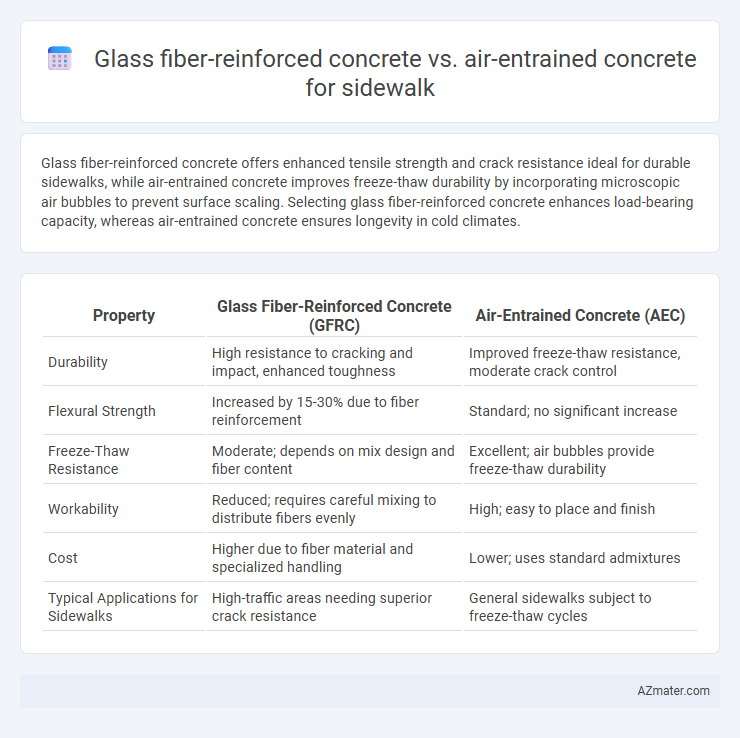Glass fiber-reinforced concrete offers enhanced tensile strength and crack resistance ideal for durable sidewalks, while air-entrained concrete improves freeze-thaw durability by incorporating microscopic air bubbles to prevent surface scaling. Selecting glass fiber-reinforced concrete enhances load-bearing capacity, whereas air-entrained concrete ensures longevity in cold climates.
Table of Comparison
| Property | Glass Fiber-Reinforced Concrete (GFRC) | Air-Entrained Concrete (AEC) |
|---|---|---|
| Durability | High resistance to cracking and impact, enhanced toughness | Improved freeze-thaw resistance, moderate crack control |
| Flexural Strength | Increased by 15-30% due to fiber reinforcement | Standard; no significant increase |
| Freeze-Thaw Resistance | Moderate; depends on mix design and fiber content | Excellent; air bubbles provide freeze-thaw durability |
| Workability | Reduced; requires careful mixing to distribute fibers evenly | High; easy to place and finish |
| Cost | Higher due to fiber material and specialized handling | Lower; uses standard admixtures |
| Typical Applications for Sidewalks | High-traffic areas needing superior crack resistance | General sidewalks subject to freeze-thaw cycles |
Introduction to Concrete Sidewalk Materials
Glass fiber-reinforced concrete (GFRC) incorporates alkali-resistant glass fibers that significantly increase tensile strength, impact resistance, and crack control in sidewalk applications, making it ideal for durability and long-term performance. Air-entrained concrete contains microscopic air bubbles that improve freeze-thaw resistance and durability by reducing internal stress caused by water expansion, which is crucial for sidewalks exposed to cold climates. Both materials enhance sidewalk longevity but serve distinct functions: GFRC focuses on structural reinforcement, while air-entrained concrete prioritizes freeze-thaw durability.
What is Glass Fiber-Reinforced Concrete (GFRC)?
Glass Fiber-Reinforced Concrete (GFRC) is a composite material consisting of Portland cement, fine aggregates, water, chemical admixtures, and alkali-resistant glass fibers that enhance tensile strength and durability. Unlike traditional air-entrained concrete, GFRC offers superior resistance to cracking, impact, and freeze-thaw cycles, making it ideal for sidewalk applications requiring long-term performance and reduced maintenance. The embedded glass fibers provide reinforcement without adding substantial weight, improving structural integrity and surface finish quality.
Understanding Air-Entrained Concrete
Air-entrained concrete incorporates microscopic air bubbles that enhance freeze-thaw resistance, making it ideal for sidewalks exposed to harsh weather conditions. This type of concrete prevents cracking and scaling by improving durability through air voids that relieve internal pressure during ice formation. Glass fiber-reinforced concrete, while offering high tensile strength and crack resistance, does not provide the same freeze-thaw protection as air-entrained concrete in sidewalk applications.
Strength and Durability Comparison
Glass fiber-reinforced concrete (GFRC) offers superior tensile strength and crack resistance compared to air-entrained concrete, making it highly effective for sidewalk applications prone to heavy foot traffic and minor impacts. While air-entrained concrete enhances freeze-thaw durability by incorporating microscopic air pockets, GFRC's embedded glass fibers provide enhanced structural integrity and longer-lasting performance against mechanical stresses. Both materials improve durability, but GFRC's strength properties deliver greater resistance to cracking and surface wear, resulting in extended sidewalk lifespan.
Resistance to Freeze-Thaw Cycles
Glass fiber-reinforced concrete (GFRC) offers enhanced resistance to freeze-thaw cycles due to the fibers bridging microcracks and reducing crack propagation, which improves durability and longevity in sidewalks. Air-entrained concrete incorporates microscopic air bubbles that provide space for water to expand upon freezing, significantly reducing internal pressure and preventing surface scaling and cracking. While air-entrained concrete is traditionally favored for freeze-thaw durability, GFRC's fiber reinforcement provides superior tensile strength and crack control, making it a robust alternative for freeze-thaw resistance in sidewalk applications.
Workability and Ease of Installation
Glass fiber-reinforced concrete offers enhanced workability due to the uniform distribution of fibers, which improves the mix's cohesiveness and reduces the risk of segregation during placement. This material provides ease of installation by allowing thinner sections without compromising strength, facilitating quicker curing times and reduced labor intensity for sidewalk construction. Air-entrained concrete, while providing excellent freeze-thaw durability, requires precise control of air content that can complicate mixing and placement, potentially affecting workability and installation efficiency.
Maintenance Requirements and Longevity
Glass fiber-reinforced concrete (GFRC) exhibits superior crack resistance and reduced shrinkage, resulting in lower maintenance requirements and longer service life for sidewalks compared to air-entrained concrete. Air-entrained concrete enhances freeze-thaw durability by trapping microscopic air bubbles, but it generally requires more frequent repairs due to susceptibility to surface scaling and wear. The enhanced tensile strength and durability of GFRC contribute to a more resilient sidewalk surface with extended longevity under heavy pedestrian traffic and environmental stress.
Cost Considerations for Sidewalk Projects
Glass fiber-reinforced concrete (GFRC) typically incurs higher initial material costs compared to air-entrained concrete due to the specialized fibers and manufacturing processes involved. However, GFRC offers enhanced durability and crack resistance, potentially reducing long-term maintenance expenses for sidewalk projects. Air-entrained concrete is more cost-effective upfront and provides improved freeze-thaw durability, making it a budget-friendly choice for cold climate sidewalks with moderate performance demands.
Environmental Impact and Sustainability
Glass fiber-reinforced concrete (GFRC) offers enhanced durability and resistance to cracking, reducing maintenance and material consumption over sidewalks' lifespan, which lowers overall environmental footprint. Air-entrained concrete improves freeze-thaw resistance by incorporating microscopic air bubbles, increasing the material's lifespan in cold climates and minimizing repair frequency, but may involve higher energy inputs during production. Both materials contribute to sustainability, with GFRC enabling longer service life and reduced raw material use, while air-entrained concrete supports durability in harsh weather conditions, making material choice dependent on specific environmental and climatic requirements.
Choosing the Best Concrete Type for Sidewalk Applications
Glass fiber-reinforced concrete offers superior tensile strength and crack resistance, making it ideal for sidewalks exposed to heavy foot traffic and environmental stress. Air-entrained concrete provides enhanced freeze-thaw durability by incorporating microscopic air bubbles that reduce internal pressure from water expansion, beneficial in cold climates. Selecting the best concrete type depends on specific site conditions, with glass fiber-reinforced concrete favored for structural resilience and air-entrained concrete preferred for freeze-thaw cycle longevity.

Infographic: Glass fiber-reinforced concrete vs Air-entrained concrete for Sidewalk
 azmater.com
azmater.com